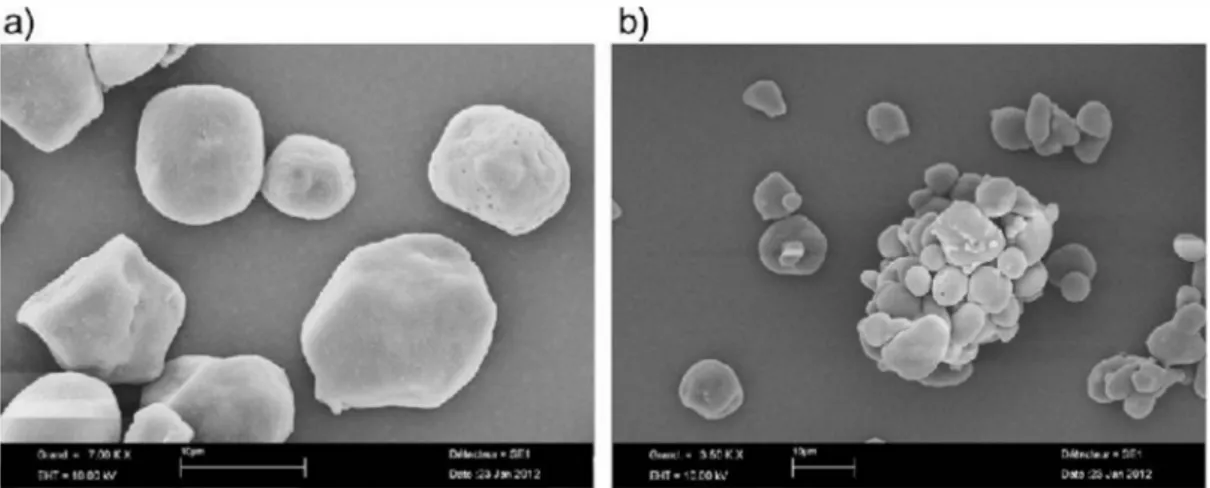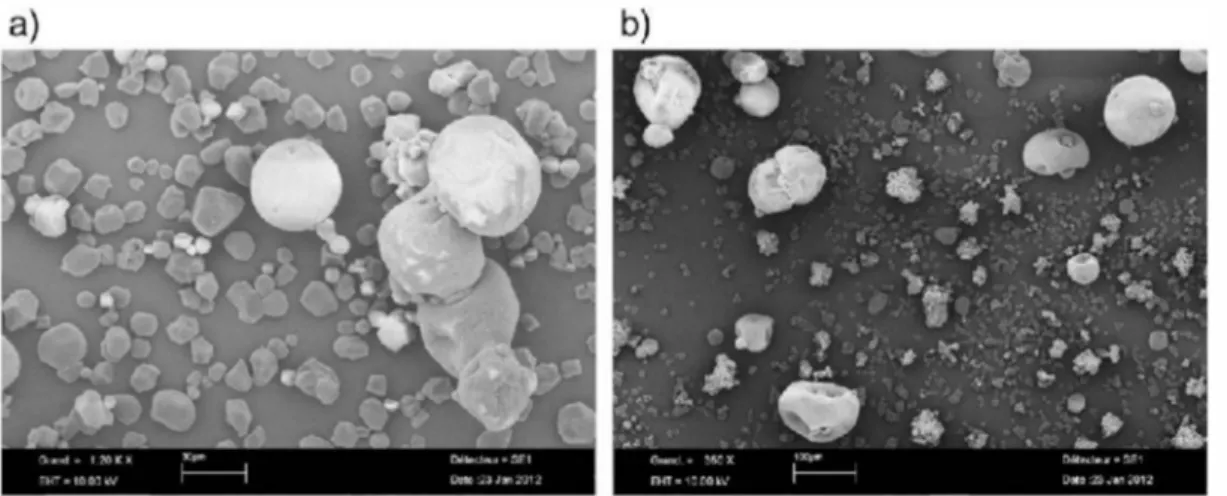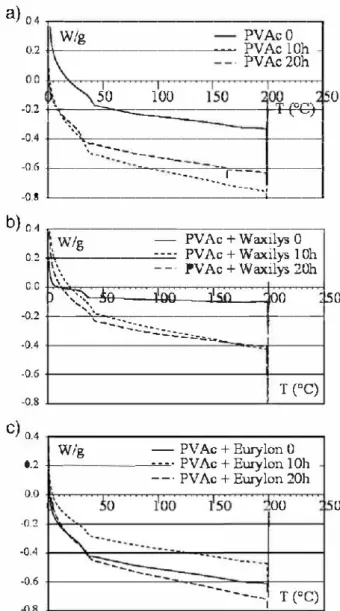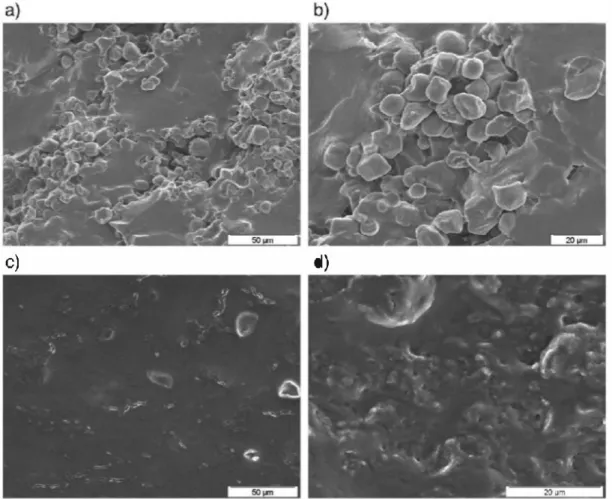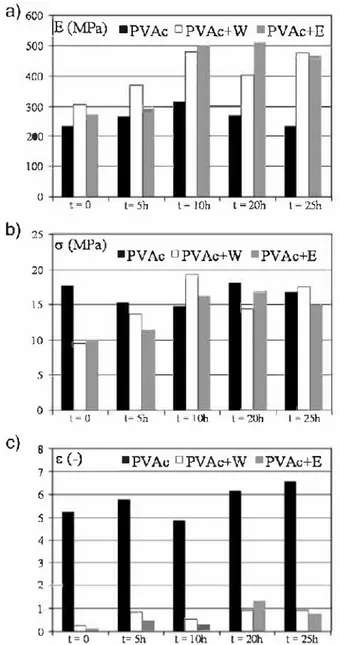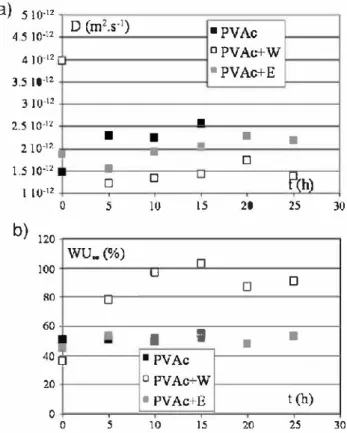OATAO is an open access repository that collects the work of Toulouse
researchers and makes it freely available over the web where possible
Any correspondence concerning this service should be sent
to the repository administrator:
tech-oatao@listes-diff.inp-toulouse.fr
This is an author’s version published in:
http://oatao.univ-toulouse.fr/20266
To cite this version:
Le Bolay, Nadine
and Molina-Boisseau, Sonia Production of
PVAc–starch composite materials by co-grinding — Influence of the
amylopectin to amylose ratio on the properties. (2014) Powder
Technology, 255. 36-43. ISSN 0032-5910
Production of PVAc-starch composite materials by co-grinding- Influence
of the amylopectin to amylose ratio on the properties
Nadine Le Bolay
a,*,Sonia Molina-Boisseau
b,ca University of Toulouse, Laboratoire de Génie Chimique, UMR CNRS 5503, ENSIACET, 4, allée Emile Monso, BP 44362, 31432 Toulouse Cedex 4, France b Centre de Recherche sur les Macramolécules Végétales (CERMAV-CNRS), BP53, F-38041 Grenoble Cedex 9, France
c Grenoble University and Member of the Institut de Chimie Moléculaire de Grenoble (ICMG) and of the PolyNat Carnot Institute
ARTICLE INFO ABSTRACT
Mixtures of polyvinyl acetate (PV Ac) filled with two starch types containing different amylopectin to amylose ra tios were co-ground in a laboratory tumbling ball mill. The influence of the starch nature and of the co-grinding treatment on the production mechanism and on the composite properties was studied. The thermal and mechan ical properties were characterized, as well as the behavior in water.
Keywords:
Co-grinding Composite materials Starch
Amylopectin to amylose ratio Properties
The presence of starch in the mixture reduces agglomeration phenomena between matrix particles, as well as the mobility of polymeric chains. While a simple mixing of the constituents generates starch concentration points in the matrix, co-grinding favors filler dispersion and PVAc-starch interactions enabling an increase of the mixture properties without adding any chemical agent The amylopectin to amylose ratio does not affect significantly me chanical properties while a high amylopectin rate promotes water uptake.
1. Introduction
Millions of tons of petrochemical polymer materials are produced each year for life usage. Most of them are used during a short period and become rapidly wastes. These materials are always more expensive. That is why starch filled composite materials were subjects of great interest during these Iast decades due to the biodegradability and the Iow price of starch.
A lot of studies are reported in literatures on composites combining starch and various polymers such as polystyrene [1,2], polyethylene
[3,4], polyvinyl acetate [5-9], polyvinyl alcohol [10-13], and polylactic acid [14-17]. Different processes are used to produce these materials: blending, chemical synthesis, and extrusion. In most cases, there are no interactions between starch and matrix, Ieading to Iow mechanical properties of materials. Indeed starch is hydrophilic while most poly mers are hydrophobie or Jess hydrophilic than starch. To avoid this problem, authors proposed to use compatibilizers, starch modification, grafting, crosslinking, and plasma treatment. Kovacs and Tabi [18], when producing polylactic acid-starch blends by injection molding, found that by using adequate drying conditions, it is possible to develop strong adhesion between starch granules and polylactic acid matrix, without any coupling agent.
Co-grinding is a simple process favoring dispersion of small tiller particles in a matrix and interactions between both constituents. This process allows improving the use properties of the materials with
* Corresponding author. Tel.: +33 5 34 32 36 82; fax: +33 5 34 32 36 97.
E-mail address: Nadine.LeBolay@ensiacet.fr (N. Le Bolay). https:/ /doi.org/10.1016/j.powtec.2013.10.050
regard to a simple mixture, without using any treatment by a chemical agent [ 19]. It was applied to fill non-degradable or biodegradable matri ces with minerais [20], non-degradable polymers [21] or starch [22,23].
Starches con tain a mixture of amylose, which has a linear structure, and amylopectin, which has a branched structure, in various propor tions depending on the sources [24]. In most studies reported in litera tures, authors used only one starch, and few studies were performed on the influence of the amylose to amylopectin ratio on properties. Zhang and Thomas [25] produced blends of polyhydroxybutyrate filled with two starches containing 30 and 72% amylopectin. They concluded that the presence of starch improves thermal, rheological and mechanical properties due to intermolecular hydrogen bonding, and the improve ment is more significant with the starch containing the higher amylose rate. Taghvaei-Ganjali et al. [26] studied the effect of amylose to amylo pectin ratio on physico-chemical properties of rubber compounds filled by three types of starches with different amylopectin contents. They showed that the tiller rubberization is enhanced with high amylopectin contents because of a higher branched structure, what influences the me chanical properties of the mixtures. Zou et al. [27] prepared starch-based superabsorbent polymers using four starches. They studied the effect of the amylose to amylopectin ratio on the grafting reactions and the perfor mance of the mixtures. They noted that the high molecular weight and branched structure of amylopectin reduces the polymer chain mobility and increases the viscosity, resulting in a lower grafting efficiency.
In a previous paper [28], composites of polyvinyl acetate filled with a waxy starch, almost essentially made of amylopectin, were produced by co-grinding. The work was mainly concentrated on the identification of grinding and co-grinding mechanisms, based on the one hand on
granulometric and morphological analyses and on the other hand on the characterization of surface properties.
In the present study, two starches with different amylose to amylo pectin ratios were used as fillers of a polyvinyl acetate matrix and the mixtures were co-ground in a tumbling ball mill during different times. Thermal and mechanical properties, as well as the behavior in water were analyzed.
2. Products, apparatus and experimental procedure
Iwo types of starch were used in this study. The first one is from waxy maize (Waxilys - Roquette Frères). It is a starch of crystalline type A, containing more than 99% of amylopectin. Grains are of polyhe dral shape (Fig. la) and the average particle size is 13 µm. The second starch is a Eurylon also issued from corn (Roquettes Frères), but of crys talline type B, containing 70% of amylose and 30% of amylopectin. Grains are rounder than those of Waxilys starch, and they are individualized or form agglomerates, some of them being rather big (Fig. 1 b ). The average size of the particles is 8.7 µm.
Polyvinyl acetate (PVAc) was gracefully supplied by the society Elotex - Switzerland. It is constituted by particles with a spheroidal shape, which are the result of the agglomeration of small grains produced by emulsion polymerization followed by drying. These spher oid particles can be single or agglomerated between them (Fig. 2, big particles). The average size of the PVAc particles is 120 µm.
In order to understand their own behavior, the three materials were dry milled alone in a 5 L ceramic laboratory tumbling ball mill (Prolabo) containing 20 vol.% ceramic balls with sizes between 5 and 12.5 mm. This range permits to always have an adapted ball to particle size ratio during grinding. The powder proportion in the mill was fixed at 20 vol.% of the interstitial void space between the balls. The rotation speed of the mill chamber was fixed at 100 rpm, corresponding to 75% of its critical rotation speed. Different experiments were performed dur ing various times, and the whole powder was recovered after each experiment to be submitted to different analyses.
Then the same runs were realized with PVAc-Waxilys and PVAc Eurylon mixtures containing 25 wt.% of starch. This rate was fixed in agreement with previous results [ 19,22] which indicated that it permits to have better use properties.
3. Characterizations
3.1. Powder analyses
Sorne analyses were done on powders directly picked up in the mill chamber. Indeed, the particle size distribution, expressed in
volume, and the median size, d50, were obtained on dry particles, using a laser diffraction granulometer Mastersizer 2000. The data were treated with the Mie theory. Three measurements were done on each sample and a maximum difference of 0.5 µm was observed between the values of the median size of a sample. Particles were also observed with a scanning electron microscope LEO 435 VP after metallization.
Other particles of the samples were analyzed by differential scanning calorimetry (DSC) using TA instruments Q2000 in nitrogen atmosphere. The temperature was increased between O and 200 °C at a rate of 10 °C•min-1. Iwo cycles were carried out and the thermo grams shown refer to the second heating, while the first cycle was used to eliminate any thermal history and moisture content in the sam ples [29]. The glass transition temperature, Tg, of the matrix was deter mined from the thermograms. Sorne analyses were repeated 3 times and the difference between the Tg values was lower than 0.5 °C. 3.2. Analyses on films
For other analyses, films of a thickness around 0.5 mm were molded in a brass mold using a Carver Laboratory Press. Powder was introduced in the mold and heated during 10 min at 150 °C, i.e. above the melting temperature of the matrix. Then a pressure of 69 bars was applied during 30 s. Finally the films were cooled in cold water in order to avoid any crystallization of the matrix.
Test specimens of 25 mm x 5 mm were eut in the films in order to characterize their mechanical properties in traction by means of an ap paratus Instron 4301, at ambient temperature and with a cross-head speed of 5 mm-min-1. The initial gap between jaws was adjusted at 10 mm. The force (F) versus elongation was obtained for each sample. The nominal stress ( a) and the nominal strain ( e) were respectively calculated by equations:
(1) (2) where Sois the initial crosssection of the film, L is the sample length and Lo its initial length. The Young modulus, E, was determined from the tangent slope of the low strain region. The strength (ab) and the maxi mum strain ( Eb) were reported for each sample. Mechanical tensile data were averaged over at least five specimens. The maximum error observed on each parameter was lower than 5%.
Fig. 2. SEM micrographs of PVAc-starch mixtures before grinding. a. PVAc-Waxilys mixture. b. PVAc-Eurylon mixture.
Films were also cooled in liquid nitrogen and then broken. Their sections were observed with a scanning electron microscope JMS 6100 JEOL after metallization.
Finally, circular pellets with a diameter of 15 mm were eut in films and placed during several months in closed flasks containing distilled water at 22 °C, in order ta study their behavior in the liquid. The water was regularly changed and the pellets weighted after removal of water from their surface with an absorbent paper sheet. The water uptake was calculated by equation:
WU= mt-mi * 100
mi (3)
where mi is the initial pellet mass before immersion in water, and mt the pellet mass after an immersion time timm• The reproducibility on water uptake was determined on three pellets of some samples for various immersion times and experiments were started at different periods of the year. A difference in WU of less than 2% was observed between the results.
Since error values are indicated in this section for each analysis and are very low, we decided not ta report error bars on figures in order ta present clearly the results.
4. Experimental results and discussion 4.1. Results of powder analyses
4.1.1. Particle size and morphology
Since these results were developed in details in a previous paper [28]
for the PVAc-waxy maize starch mixture, we only synthesize here those necessary for understanding the study presented in this article, and we add data on PVAc-Eurylon mixture.
During their individual grinding, Waxilys particles are not fragmented because their initial size (given in Section 2) is lower than the limit size being able ta be reached during macromolecule grinding (few tens ofµm) [30]. On the contrary, they even agglomer ate and the median size tends ta increase slightly ta reach 30 µm. As for Eurylon, big agglomerates break during the first minutes. Then one observes the same agglomeration behavior as with the Waxilys starch.
Fig. 3 shows the variation of the median size of PVAc particles ground atone and of the co-ground mixtures.
Concerning the matrix, big agglomerates observed in Fig. 2 are first fragmented at the level of the particle joints ta individualize the particles constituting them. Then, the individual particles are
fragmented progressively, leading ta a decrease of their median size down ta 40 µm. When this minimum size is reached, fragment agglomeration occurs and the median size increases. Finally, this one oscillates due ta a competition between agglomerate fragmenta tion and re-agglomeration.
Bath PVAc-starch mixtures have the same behavior during co grinding, but their median size evolves differently from the matrix atone. Indeed, in the mixtures, matrix particle are first broken and those of starch stick on PVAc fragments. This is confirmed by the SEM micrograph of Fig. 4a taken after one hour co-grinding: one can observe big PVAc fragments on which small starch grains are stuck The median size decreases. Starch coats gradually the PVAc fragments, the fragmen tation of which continues. The whole is then compacted under the effect of balls (Fig. 4b and c). However, contrary ta what was noted during the grinding of the matrix atone, we observe few re-agglomeration phe nomena with mixtures. The median size stabilizes then towards 25 µm. One can say that, in a mixture, agglomeration of starch grains on matrix fragments is favored compared ta matrix-matrix fragment agglomeration.
4.1.2. Thermal properties
DSC analyses were done on powders of the two starches, the matrix and the mixtures unground and co-ground at different times, and we focused on the second heating scan.
140 120 100 80 60 40 20 0
..
0 d50 (µm)B
•
.... g g s 10 •PVAc • PV Ac+ Waxilys 6 PV Ac + Eurylon•
....
-�"
[l 0 t (h) 15 20 25 ]0Fig. 3. Variation of the median size of the samples with and without starch during grinding.
b)
c)
Fig. 4. SEM micrographs of co-ground mixture particles. a. PVAc-Waxilys (t = 1 h); scale = 20 µm. b. PVAc-Waxilys (t = 15 h); scale = 10 µm. c. PVAc-Eurylon (t = 25 h); scale = 20 µm.
As Sreekumar et al. [12] and Othman et al. [29] have already observed previously, the thermograms of bath starches are fiat.
Fig. Sa gathers PVAc thermograms for three grinding times, white
Fig. Sb and c present those of the mixtures for the same times. The samples taken at other times were also analyzed but their thermograms are not presented in these figures to have them clear enough.
One can note on these figures an inflection of the curves at a temper ature lower than 50 °C. This corresponds to the PVAc glass transition temperature which was determined from ail the thermograms. The values are gathered in Fig. 6.
As for polyvinyl acetate, it was noticed that the glass transition temperature, initially at 40 °C, decreases when grinding is operated.
a)
o.4 ..---. W/g PVAcO 0.2 tt--- PVAc 10h PVAc20h50
100 -0.2K.-:-... --=::,,,_...:;;:::::=:::=:::::::=---,±'-t''bfi
.... � -0.4 __ _..,__,---
. -
_______________ ...·
-
.
----0.6 +---�=-��--�r=-�-�-=-+---1...
.... ��._
- ... , -0.8 �---�---� b) o� �---� r,W/g -- - --0.2 --- i-1'. 0.0 \\ · --· PVAc + Waxilys 0 PV Ac+
W axilys 1 Oh PV Ac + W axilys 20h 0 ·,,,v, -- -,, <;f\ '00, l'i
0D
���--��:\:1-:---AllY---_.J;,.!l.l,l.,___-.:.J....
-0.2 +---__,-.,.,•-,-..,,---+---1 ""-�:.·..::::..•---0.4 -0.6 -0.8c)
o.4 0.2 0.0 -0.2 -0.4 -0.6 -08 -�.:.--==---.:..�--Tc
□c) W/g - PVAc+
Eurylon 0 +---�-�-�- · PV Ac+
Eurylon 1 Oh --· PVAc + Eurylon 20h 00 ---1 T (°C) 0Fig. 5. Thermograms of the matrix and the mixtures for some grinding times. a. PVAc thermograms. b. Thermograms of PVAc + Waxilys. c. Thermograms of PVAc + Eurylon.
This treatment can lead to a scission of the molecular chains of the poly mer [31], leading to a reduction ofits molecular weight, and as a conse quence, of its glass transition temperature. The grinding time does not have a significant effect on Tg.
50 Tg
c
0
c)
40■
ô 6�
Il
•
30 ♦PVAc•
■
PVAc + Waxilys t:,. PV Ac - Eury lon t (h) 10 0 5 10 15 '20 25 30When mixing starch to PVAc (t
=
0), the matrix glass transition temperature is decreased because ofhydrogen bonding between matrix and tiller. Othman et al. [29] determined the melting and the crystalliza tion temperatures of polyvinyl alcohol and corn starch blends. They ob served the same decrease in these temperatures. Moreover the value of Tg, at t=
0 in Fig. 6, is very slightly lower in the presence of the starch with the higher amylose rate. Indeed, the linear structure of amylose favors hydrogen bonding compared to the crosslinked structure of amylopectin. Zhang and Thomas [25] produced blends of poly hydroxybutyrate and starches with various amylose to amylopectin ra tios and they also noticed a lower value ofîg with blends containing the higher amylose rate.Nevertheless, co-grinding increases the glass transition tempera ture. This can be due to a better dispersion of the tiller in the matrix ( that will be contirmed in the next section), leading to a more stable sys tem in which the mobility of the molecular chains is reduced. With co grinding, the difference between the values of Tg for the two mixtures is more important in favor of the mixture containing the starch with the higher amylopectin rate.
4.2. Properties detennined on films 4.2.1. SEM observation of film section
Fig. 7 presents micrographs of the sections of composite films tilled with Waxilys, respectively by simple mixture, and after 10 and 20 h of co-grinding. The same type of micrographs was obtained with the mixture PVAc-Eurylon.
On micrographs a and b, the starch grains are clearly recognizable. Moreover, adhesion between starch grains and the matrix is weak, what is highlighted by the absence of any physical contact between both components. The starch grains seem extracted from the matrix
c)
during the cutting of the composite film. Finally, we note zones of tiller concentration, while other zones are exempt from it.
When matrix and tiller are co-ground before molding, the film sections are very different. Indeed, some starch grains are still observable after 10 h, but they seem stuck in the matrix (micrograph c). After 20 h, no grain is observable (micrograph d).
These observations allow validating the interest of co-grinding to improve the dispersion of the tiller in the polyvinyl acetate matrix.
4.2.2. Mechanical properties
The evolutions of the tensile modulus, strength and maximum strain versus co-grinding time are shown in Fig. 8 for the three materials (PVAc films, mixture PVAc-Eurylon, mixture PVAc-Waxilys).
The untilled matrix displays a viscoelastic behavior with a high tensile modulus (around 250 MPa), a high strength (around 15 MPa) and a low strain (around 6). The grinding time does not have a signiti cant effect on the mechanical properties of PVAc films what is consistent with the results obtained on the evolution of the glass transition temperature of the powder samples.
For low grinding times, adding starch particles results in an increase of the tensile modulus and in a decrease of both the strength and maximum strain. The PVAc materials tilled by starch particles became brittle. This result is therefore an indication of the Jack of intimate adhe sion between both components of the composite structure. This is con firmed by the observation of the SEM micrographs of the film sections (Fig. 7a and b).
Vargha and Tru ter [ 5] studied the mechanical behavior of mixtures produced by partial trans-esteritication of polyvinyl acetate and starch. They could not measure the mechanical properties of samples of such composites which were very brittle contrary to polymer alone.
d)
a)
600 �CMPa) 500 4[)0 300 200-
-100-
-0 --0b)
25 a (MPa) 20 1.5 10 � 5-
� 0 t= 0c)
8 f: (-) 7 6 5 4 3 2-
----.
0 t= 0■PVAc
□
PVAc+W ■PVAc+E-..
-l= Sh -l- !Oh l -20h �-----
-- -- -t-25h•PVAc □PVAc+W •PVAc+E
I"' -., l- Sn �
-;:::: --� l- !Oh t=20h--
--- ---�
-
-l = 25h •PVAc □PVAc+W •PVAc+E---h
7-,1
1
t= Sh t=Hh t= 20h t = 25hFig. 8. Mechanical properties of the matrix and the mixtures. a. Tensile modulus. b. Strength. c. Maximum strain.
After 10 h of co-grinding, the filled films display a higher relative reinforcing effect. For instance, the Young modulus of a film reinforced with 25 wt.% of starch increased by a factor of 1.5 and the strength was of the same order as that for the unfilled materials. These results
120 100 80 60 40 20 0 WU(%)
•t
=O
+---1 ô. t = 5h +---< • t=
l Oh o t = 15h 10 102 HJ 10' JO' Hl"Fig. 9. Influence of immersion and grinding rimes on PVAc water uptake.
confirm that the co-grinding process allows a better cohesion between the tiller and the matrix. Nevertheless, the composite materials remain brittle with a low strain.
Concerning the influence of the starch type on the mechanical prop erties, we cannot conclude because the tendency varied with the oper ating conditions.
4.2.3. Behavior in water and characterization of diffusional phenomena
Fig. 9 presents the variation of the water uptake of the matrix pellets immersed during different times, parameterized by the grinding time. The time scale is logarithmic to better analyze the phenomena taking place within the first immersion hours.
WU increases first with the immersion time, as water diffuses in pellets, to level off after 1000 min at a maximum value between 50 and 55%, corresponding to equilibrium in water uptake. This progressive increase may be attributed ta a hydrophilic behavior of PVAc which is moderate given the maximum values of WU. We observe a small influ ence of the grinding time on the maximum value reached, due to a mod ification of the molecular chains as expressed previously. Finally, the water uptake decreases progressively during the few months of the experiment
As for mixtures (Fig. 10), similar evolutions are observed when the matrix is filled with starch having a high amylose rate. Eurylon seems ta have the same hydrophilic behavior in water than PVAc.
On the contrary, Waxilys is a highly hydrophilic starch due ta the fact that amylopectin structure is more open and consequently can absorb more water than amylose. Kibar et al. [32] also noted that water uptake of mixtures filled with starch increases as the amylose rate decreases. Mani and Bhattacharya [33] evoked an increase of the gelatinization and a degradation of the ramified structure of amylopectin that make the mixture more sensitive ta water. Without co-grinding (t
=
0), the maximum water uptake is a little bit lower than for the two other systems, but this difference must be taken with care because of the dis persion irregularity of starch in matrix when unground. Indeed, in ordera)
120 100 80 60 40 20 ()b) m
100 80 60 40 20 0 WU(%) •t = 0 "t = 5h •t = 10h "'t = 20h 0 t = 25h 10 WU(%) lO 102 1(,: A•
JO' 10' 10' 1 O" • L =0 Àt =5h •t = 10h •t =20h 0t=25h JO' 10" ,a� 10"Fig. 10. Influence of immersion and co-grinding times on mixture water uptake. a. PV Ac-Waxilys mixtures. b. PVAc-Eurylon mixtures.
the filler plays its real role, it needs to be well dispersed within the matrix to create a network. Bridges generated by the contact between starch grains will favor the water absorption in the whole pellet. How ever, as can be seen on the micrographs of Fig. 7b, pellets contain aggre gates of starch grains surrounded with unfilled matrix. A simple mixture of the constituents does not thus generate this network. However, once water has saturated matrix, it can reach concentrated starch zones and water absorption by the very hydrophilic starch can proceed. This is translated by the peak in the WU curve after 100 000 min of immersion. Water uptake kinetics and maximum value are greatly influenced by the co-grinding time, WU at equilibrium being close to 100% in some cases. Co-grinding favors the progressive dispersion of starch grains and the formation of a network through the pellets. Once this network established (after 10 h co-grinding) a longer co-grinding treatment has no significant effect on the first part of the curves and on water up take equilibrium. As for the WU decrease (last part of the curves ), it is more pronounced than for the two other systems. This may be attribut ed to starch release, as already suggested by Vargha and Truter [5] and by Angellier et al. [34].
Above the polymer glass transition temperature, chain relaxation is rapid and water diffusion within the polymer network may happen according to Fick laws. Below the glass transition temperature, chain relaxation is slower. According to Alfrey et al. [ 35 ], transport phenome na into glassy polymers may be described by three models:
- The water diffusion rate is lower than the relaxation rate of polymer ic chains. The mechanism is controlled by diffusion which is Fickian; - The relaxation rate is lower than the water diffusion rate. The mech
anism is thus controlled by chain relaxation; - Both rates are comparable.
Frisch [36] expressed the mechanism of water diffusion by the following equation, valid for values of the left member of the equation lower than 0.6:
m1-mi _ k. tn .
m«'-mi - mn (4)
where m� is the pellet mass at equilibrium, timm the immersion time, k the system constant and n the diffusional exponent depending on the diffusion mechanism. The exponent n is equal to 0.5 if the diffusion is Fickian.
This equation was applied to the results presented in Figs. 9 and 10, by expressing the logarithm of the left member of the equation versus the logarithm of the immersion time. Exponents n, equal to the slope, were determined for the various operating conditions and are gathered in Fig. 11. They are close to 0.5, indicating that the mechanism of water penetration into the pellets is controlled by Fickian diffusion. The inter cept points of the straight lines were also determined.
0 7 0.6 0,5 0,4 0.2 0.1 1 0 0 n (-) u r,
■
r,�
�
-
•
-•PVAc □PVAc+W ■PVAc+E t (h) 5 l() 15 2() 25 30Fig. 11. Diffusional exponent versus co-grinding time.
a)
5 10·12 4.5 ]0·'2 4 ]0·12 3.5 ]û·lZ 310-1� 2.5 10•1L 2 10-12 1.5 JO·" 1 10-12b)
120 100 80 60 40 20 0�
Il 0u
[J 0D
(m
2.
s
·
1)■
•
D 5 WU,.(%) u 5 •PVAc □ PVAc.-+W ■PVAc+E-■
-
■
■
-
□
□
P(h)
10 15 20 25 30n
u□
□
C
l'.2■
•
■ PVAc
□PVAc+W■
PVAc
+
E
t (h) 10 15 20 25 30Fig. 12. Diffusion exponent and water uptake at equilibrium versus co-grinding time. a. Diffusion exponent b. Water uptake at equilibrium.
ln that case, Crank [37] precised that the constant k is equal to (4 / e) • (D / rr)0·5, where e is the pellet thickness and D the diffusion coefficient. D was thus calculated from the intercept points of the lines and the values are shown in Fig. 12, as well as the water uptake at equilibrium.
For the reason previously evoked of a bad dispersion of the filler in the matrix, data obtained for unground materials will not be discussed. When grinding is performed, one can notice that the diffusion coeffi cient is lower for mixtures than for the matrix alone. Moreover, the higher the amylopectin rate, the lower the diffusion coefficient. Finally the diffusion coefficient increases slightly with an increase of the co grinding time up to 20 h. This may be attributed to higher inter- and intra-molecular interactions in the presence of starch, which reduce chain mobility. These interactions slow down water diffusion. This is particularly the case for waxy starch with its ramified structure. These results are in accordance with the evolution of the glass transition temperature previously discussed, which is the highest in the presence of waxy starch and the lowest for the matrix alone. When the grinding time increases, the chain length decreases leading to a small enhance ment of the diffusion coefficient.
Concerning the values of WU�, they are similar and constant for the matrix and the mixture filled with starch containing the high amylose rate, whatever the grinding time, while those of mixtures containing starch with a high amylopectin rate are higher, in accordance with explanations given for Figs. 9 and 10 on the variation of the water uptake.
5. Conclusions
A study on co-grinding polyvinyl acetate filled with starch was per formed in order to show the opportunity of partially replacing the syn thetic matrix by a vegetable, degradable and available filler. Iwo starches having different amylopectin to amylose ratios were used.
Granulometric and morphological analyses have permitted to define the mechanism by which the composite material is formed. Co-grinding
permits a better dispersion of the tiller in the matrix than a simple mixing, thus favoring PVAc-starch interactions. Mechanical properties of materials in traction are thus improved.
The glass transition temperature of polyvinyl acetate was deter mined by DSC analysis. The tiller presence leads to an increase of Tg due to a limitation of the polymeric chains mobility. Consequently, the higher the ramitied amylopectin rate, the higher the glass transition temperature.
Moreover, the presence of starch with a high amylopectin rate favors the composite water uptake if starch is well dispersed in the matrix under the effect of an optimized co-grinding treatment. Starch nature, linked to its botanical origin, influences the properties of composites produced by co-grinding.
Nomenclature
D diffusion coefficient m2 /s dSO particle median size µm e pellet thickness m E Young modulus Pa
F force N
L sample length m
Lo sample initial length m mi initial pellet mass kg mt pellet mass at time t kg m� pellet mass at equilibrium kg n diffusional exponent
So initial crosssection of the film m2 t grinding time s
T temperature °C
Tg glass transition temperature °C timm immersion time s
wu
water uptake %WU� water uptake at equilibrium %
E nominal strain % Eb maximum strain % 0 nominal stress Pa
ot, strength Pa
References
[ 1] TAP.F. Pimente!, J.A. Duraes, AL. Drummond, D. Schlemmer, R Falcao, M.JA Sales, Preparation and characterization of blends of recycled polystyrene with cassava starch,J. Mater. Sei. 42 (2007) 7530-7536.
[2] HA Pushpadass, RW. Weber, MA Hanna, Expansion, morphological and mechan
ical properties of starch-polystyrene foams containing various additives, Ind. Eng. Chem. Res. 47 (2008) 4736-4742.
[3] D. Danjaji, R Nawang, U.S. Ishiaku, H. Ismail, ZAM. Ishak, Sago starch-filled linear low-density polyethylene (LIDPE) films: their mechanical properties and water ab sorption,]. Appl. Polym. Sd. 79 (2001) 29-37.
[4] H.P.S. Abdul Khalil, W.C. Chow, H.D. Rozman, H. Ismail, M.N. Ahmad, RN. Kumar, The effect of anhydride modification of sago starch on the tensile and water absorp tion properties of sago-filled linear low-density polyethylene (LIDPE), Polym. Piast Technol. Eng. 40 (2001) 249-263.
[5] V. Vargha. P. Truter, Biodegradable polymers by reactive transesterification ofther moplastic starch with poly (vinyl acetate) and poly (vinyl acetate-co-butyl acry late), Eur. Polym.J. 41 (2005) 715-726.
[ 6] A Waly, FA Abdel-Mohdy, A Hebeish, Chemical modification of starch-poly ( vinyl acetate) materials, Polym. Polym. Campos. 6 (1998) 161-170.
[7] D. Lu, C. Xiao, F. Sun, Controlled grafting of poly(vinyl acetate) onto starch via RAFT poiymerization,J. Appl. Polym. Sei. 124 (2012) 3450-3455.
[8] Y.H. Zhang,J.Y. Gu, H.Y. Tan, M.W. Di, Z.G. Li, Q. Si, Study on film ofpolyvinyl acetate emulsion modified by starch, Adv. Mater. Res. 403-408 (2012) 80-83.
[9] Y. Nie, X. Tian, Y. Liu, K. Wu, J. Wang, Research on starch-g-polyvinyl acetate and epoxy resin-modified corn starch adhesive, Polym. Campos. 34 {2013) 77-87. [10] X. Tang, S. Alavi, Recent advances in starch, polyvinyl alcohol based polymer blends,
nanocomposites and their biodegradability, Carbohydr. Polym. 85 (2011) 7-16. [11] L.T. Sin, WAWA Rahman, AR Rahmat, T.-T. Tee, S.T. Bee, L. Chong-Yu, Computer
aided injection moulding process analysis of polyvinyl alcohol-starch green biode gradable polymer compound,J. Manuf. Process. 14 {2012) 8-19.
[12] P.A. Sreekumar, M.A. AI-Harthi, S.K. De, Studies on compatibility ofbiodegradable starch/polyvinyl alcohol blends, Polym. Eng. Sei. 52 (2012) 2167-2172. [13] F. Parvin. A. Rahman. J.M.M. Islam, M.A. Khan, A.H.M. Saadat. Preparation and char
acterization of starch/PVA blend for biodegradable packaging material, Adv. Mater. Res. 123-125 (2010) 351-354.
[14]J.F. Zhang, X. Sun, Mechanical properties of poly(lactic aeid)/starch composites compatibilized by maleic anhydride, Biomacromolecules 5 (2004) 1446-1451. [15] R Aeioli-Moura, X.S. Sun, Thermal degradation and physical aging of poly(lactic
add) and its blends with starch, Polym. Eng. Sei. 48 (2008) 829-836.
[16] H. Wang, X. Sun, P. Seib, Mechanical properties of poly(lactic aeid) and wheat starch biends with methyienediphenyI diisocyanate, J. Appl. Poiym. Sei. 84 (2002) 1257-1262.
[17] N. Wang,J. Yu, P.R Chang, X. Ma, Influence of formamide and water on the proper ties ofthermoplastic starch/poly (lactic add) blends, Carbohydr. Polym. 71 (2008) 118-119.
[18]J.G. Kovacs, T. Tabi, Examination of starch preprocess drying and water absorption of injection-molded starch-filled poly(lactic aeid) products, Polym. Eng. Sei. 51 (2011) 843-850.
[19] C. Zapata, N. Le Bolay, C. Frances, S. Molina-Boisseau, Production of smalt composite particles by co-grinding in a media mill - characterization of the granulometric and the mechanical properties, Trans. IChemE, Part A, Chem. Eng. Res. Des. 82 (AS) (2004) 631-636.
[20] C. Zapata-Massot, N. Le Bolay, Effect of the minerai filler on the surface properties of co-ground polymeric composites, Part Part. Syst. Charact 24 (2007) 339-344. [21] J. Pan, W J.D. Shaw, Effect of processing parameters on material properties of me
chanically processed polyamide,]. Appl. Polym. Sd. 56 (1995) 557-566. [22] A. Seyni, N. Le Bolay, A. Lamure, Matrix-filler interactions in a co-ground
ecocomposite - surface properties and behaviour in water, Powder Technol. 208 ( 2011 ) 390-398.
[23] N. Le Bolay, A. Lamure, N. Gallego Leis, A. Subhani, How to combine a hydrophobie matrix and a hydrophilic filler without adding a compatibilizer - co-grinding en hances use properties of renewable PIA-starch composites, Chem. Eng. Process. 56 (2012) 1-9.
[24] M. Ramesh, J.R Mitchell, S.E. Harding, Amylose content of rice starch, Starch 51 (1999) 311-313.
[25] M. Zhang, N.L Thomas, Preparation and properties ofpolyhydroxybutyrate biended with different types of starch, J. Appl. Polym. Sei. 116 (2010) 688-694.
[26] S. Taghvaei-Ganjali, F. Motiee, E. Shakeri, A Abbasian, Effect of amylose/amylopectin ratio on physico-mechanical properties of rubber compounds filled by starch, J. Appl. Chem. Res. 4 (2010) 53-60.
[27] W. Zou, L. Yu, X. Liu, L Chen, X. Zhang, D. Qiao, R Zhang, Effects of amylose/amylopectin ratio on starch-based superabsorbent polymers, Carbohydr. Polym. 87 (2012) 1583-1588.
[28] A. Seyni, N. Le Bolay, S. Molina-Boisseau, On the interest of using degradable fillers in co-ground composite materials, Powder Technol. 190 (2009) 176-184. [29] N. Othman, N.A. Azahari, H. Ismail, Thermal properties of poiyvinyl alcohol
(PVOH)/corn starch biend film, Maiaysian Polym. J. 6 (2011) 147-154. [30] K. Schèinert. Size reduction (fundamentals) - chap. 1, Ulmann's Encyclopedia ofin
dustrial Chemistry1988. 5.1-5.14.
[31] S. Molina-Boisseau, N. Le Bolay, Characterisation of the physico-chemical prop erties ofpolymers ground in a vibrated bead mill, Powder Technol. 128 (2002) 99-106.
[32] E.AA. Kibar, I. Gonec, F. Us, Gelatinization ofwaxy, normal and high amylose corn starches, Gida 35 (2010) 237-244.
[33] R Mani, M. Bhattacharya, Properties of injection moulded starch/synthetic polymer biends - Ill. Effect of amylopectin to amylose ratio in starch, Eur. Polym.J. 34 (1998) 1467-1475.
[34] H. Angellier, S. Molina-Boisseau, L. Lebrun. A. Dufresne, Processing and structural properties of waxy maize starch nanocrystals reinforced natural rubber, Macromol ecules 38 (2005) 3783-3792.
[35] T. Alfrey, E.F. Gurnee, W.G. Lloyd, Diffusion in glassy polymers,J. Polym. Sd., Part C 12 (1966) 249-261.
[36] H.L Frisch, Sorption and transport in glassy polymers - a review, Polym. Eng. Sei. 20 (1980) 2-13.
[37] J. Crank, Mathematics ofDiffusion, 2nd ed. Oxford University Press, New York, 1975. 45-50.
